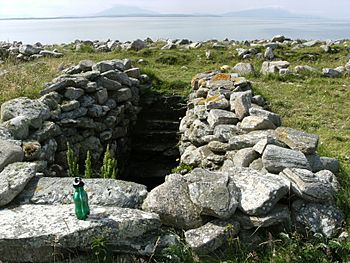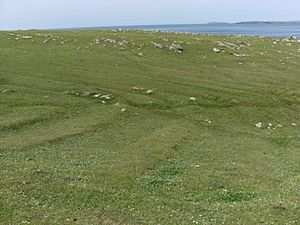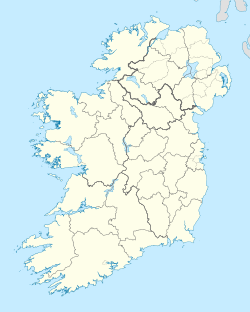Inishglora facts for kids
|
Native name:
Inis Gluaire
|
|
|---|---|

A freshwater well on Inishglora
|
|
| Geography | |
| Location | Atlantic Ocean |
| Coordinates | 54°12′36″N 10°07′41″W / 54.210°N 10.128°W |
| Highest elevation | 22 m (72 ft) |
| Administration | |
| Province | Connacht |
| County | Mayo |
Inishglora (Irish: Inis Gluaire) is a small island off the coast of County Mayo in Ireland. It's located near the Mullet Peninsula in an area called Erris. There are also a few tiny islands nearby called Inishkeeragh. No one has lived on Inishglora since the early 1900s, but you can still find the remains of several old churches there.
Island Geology
Inishglora's rocks are very similar to those on the nearby Inishkea Islands. Both islands are made of ancient rocks called gneiss and schist. These are the same types of rocks found across the rest of Erris. The island's surface is mostly covered with a special kind of grassy land called machair and bright white sand.
It's interesting to see how Inishglora and the Inishkea Islands look different from Duvillaun, which is a short distance south. From the mainland, Inishglora and the Inishkeas look bright white and green in the sun. But Duvillaun looks much darker because its rocks are different, similar to those on Achill Island further south.
Island History
Inishglora is probably the most famous of the islands off Erris. Many people consider it the holiest of all these islands. It sits north of Duvillaun and the two Inishkea Islands.

You can find several old ruins on the island. The remains of Saint Brendan's Church suggest it was built in a style similar to the famous Gallarus Oratory in County Kerry. There are also ruins of two other churches: Teampall na bhFear (which means Men's Church) and Teampall na mBan (Women's Church). The Women's Church might have been an early nunnery, a place where nuns lived. These two churches are more recent than Saint Brendan's Church, dating back a few centuries.
You can also see the remains of three beehive huts. These are small, round stone huts. The biggest one is known as Saint Brendan's cell. There are many old stories and superstitions about the religious relics found on Inishglora.
One famous story is about Saint Brendan's Well. People used to say that if a woman tried to take water from it, the water would turn into blood and fill with worms! However, these stories might have been made up long ago to stop nuns and monks from secretly meeting at the well. Inishglora also has several ancient cross slabs and stone pillars.
Legends and Old Writings
One of the most famous Irish legends, the Children of Lir, is connected to Inishglora. The story says that the Children of Lir, who were turned into swans by their jealous stepmother, flew to Inishglora after 900 years of being banished. On the island, Saint Brendan the Navigator baptized them. They then changed back into their human forms. But because they were 900 years old, they immediately turned to dust. It is believed they were buried on the island.
A writer named Geraldus Cambrensis wrote about Inishglora in 1186 AD in his book Topographia Hibernica. He mistakenly called it Aren, but he said something very interesting about the island:
- "There is an island... where human bodies are neither buried nor decay, but, placed in the open air, remain uncorrupted."
He also wrote that people could see and recognize their ancestors from a very long time ago.
The Book of Ballymote, another old Irish text, also mentions that bodies on Inishglora do not decay. A poem by Roderic O'Flaherty from 1685 seems to agree:
- At Inisglóire in view of lrrus shore,
- Should we the bodies of our sires explore,
- We'd find them blooming, both nails and hair,
- No human-flesh can fade or perish there.
Today, there are no "uncorrupted" bodies on Inishglora. Many bones have been found buried around the island. Local people believe that after the religious communities left the island, things went back to normal.
Geraldus Cambrensis also wrote another curious thing about Inishglora:
- "There is another remarkable thing in this island. Although mice (possibly black rats) swarm in vast numbers in other parts of Ireland, here not a single one is found. No mouse is bred here, nor does it live if it be introduced; when brought over, it runs immediately away and leaps into the sea. If it be stopped, it instantly dies."


